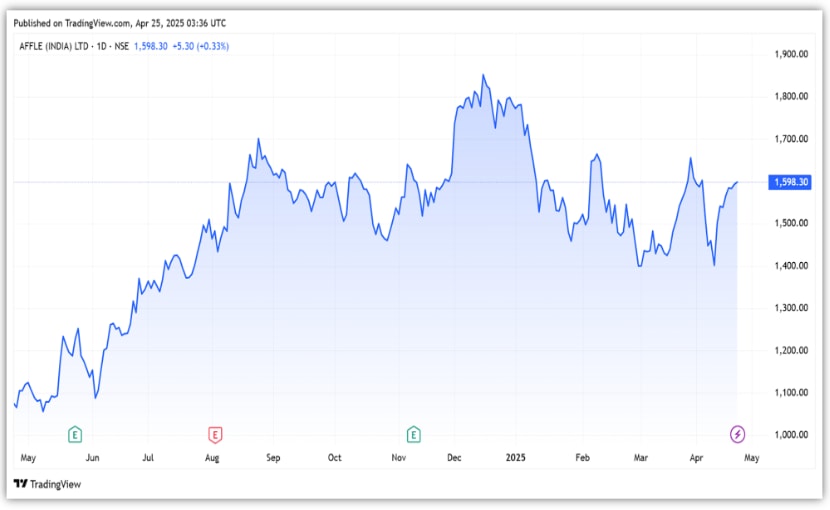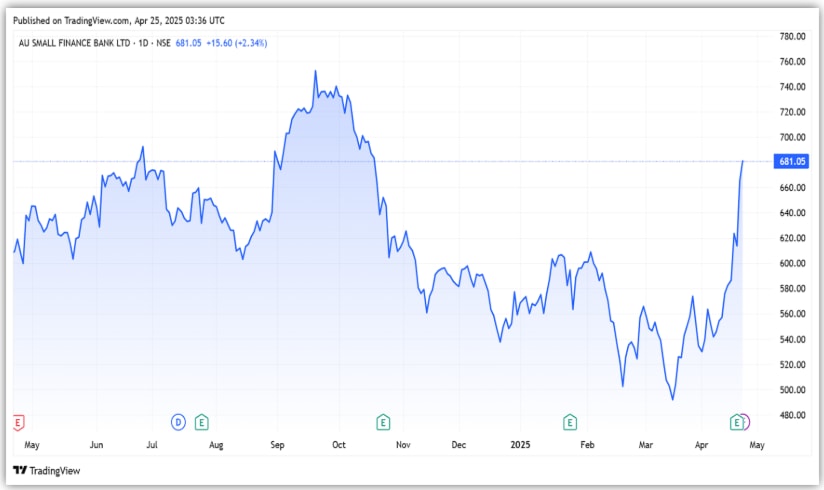Choosing successful stocks is a challenging task for investors across sectors. This is because you need to consider various aspects while investing in and evaluating a company. This includes financial performance, valuation, quarterly results, etc. When put together, it becomes an overwhelming task.
And even when you’ve done everything right, there’s no certainty whether the stock will perform. One of the main reasons is that investors often fail to distinguish between high-quality businesses and sound investments. A company with strong operational efficiency and a solid balance sheet does not automatically qualify as an investment candidate, because quality does not necessarily mean it has growth potential.
With this context in mind, we have selected these two stocks. They are high-quality companies with moderate to high growth and reasonable valuation.
#1 Affle (India)
Affle is a global technology company that delivers consumer recommendations and conversions through relevant mobile advertising for leading B2C companies globally.
Its proprietary consumer intelligence platform serves as an end-to-end adtech value chain proposition, delivering personalised consumer recommendations and conversions through mobile advertising. The platform has 3.3 billion connected devices.
The company has a strong patent portfolio. Affle has received nine patents in the US and India, related to digital advertising, artificial intelligence, voice intelligence, and other areas. In addition, 27 patents have been filed for future use cases.
The company’s geographical presence is diversified across India, emerging and developed markets. As of FY24, 74% of Affle’s revenue comes from India and emerging markets, while the remaining 26% comes from developed markets.
Affle’s revenue engine is driven by the cost per converted user (CPCU) model. This includes user conversions based on consumer acquisition, engagement and transaction models.
This, in turn, is primarily driven by advertisers’ performance marketing spend, with payments based on results achieved. In addition, Affle also earns revenue through brand awareness campaigns.
Affle’s financial performance has been outstanding, driven by rising demand for digital advertising and strong client additions across geographies. The company has also benefited from operating leverage and its focus on high-margin, ROI-linked ad solutions.
The company’s revenue grew at a compound annual growth rate of 53% from FY20 to FY24, reaching ₹18.4 billion in FY24, a 28.5% increase from FY23. Net profit, on the other hand, grew at a 46% CAGR to ₹2.9 billion, up 23% from the previous year.
Affle’s earnings before interest, tax, depreciation, and amortisation (EBITDA) grew at a 23% CAGR to ₹3.6 billion in FY24, with stable margins of around 20%. With strong profitability, its return on equity (ROE) and return on capital employed (ROCE) stand at 17% and 16.5%, respectively, indicating efficient capital utilisation.
In FY24, Affle reported strong operating metrics, with the number of converted users growing 22% to 313 million compared to the prior year. Average cost per converted user (CPCU) also rose 10% to ₹56.20, reflecting improved monetisation per user. As a result, CPCU revenue grew sharply by 33.5% to ₹17.6 billion, reflecting both volume growth and pricing power.
The momentum continued in 9MFY25 as well. Affle’s revenue increased 24.5% to ₹16.6 billion, driven mainly by a 28.6% growth in conversions. At the same time, net profit increased 33% to ₹2.8 billion, with a margin of 21%.
Looking ahead, Affle shared three key initiatives to pursue growth. The first is to focus on innovation, which includes prioritising consumers as stakeholders. The second focus will be to make an impact on advertisers and the advertising ecosystem, expanding the target market and driving the next phase of growth.
It is also trying to enhance intelligence with AI agents in its third initiative. The company unveiled Optics AI to improve its consumer platform, providing highly personalised, hyper-relevant, and localised creatives for an optimised user experience.
Moreover, the company also showcased CTV AI, which aims to transform and scale millions of small and medium businesses to advertise effectively. The company believes that through innovations like Optics AI and CTV AI, it will be able to grow its customer base 1,000 times this decade, reaching over 1 million advertisers.
The company expects to grow revenue at a rate of at least 25-30% CAGR over the next five years, as it strengthens its market position by focusing on its CPCU model, expanding its reach to connected devices and entering new geographies.
The company trades at a PE ratio of about 62, an 8% discount to its five-year median PE of 67.
Affle Share Price

#2 AU Small Finance Bank
AU Small Finance Bank (AU SFB) was incorporated in 1996 as an NBFC, with 28+ year track record as a retail-focused institution. It commenced its banking operations in April 2017. It has established operations across 2,456 banking touchpoints serving 11.3 million customers in 21 states and 4 union territories.
It is geographically well-diversified, with a strong presence in Rajasthan, and has expanded its operations to Maharashtra, Gujarat, and other states over the years. North India contributes 42% of gross loans and 53% of deposits, followed by the West and South.
It boasts a total loan portfolio of ₹1.15 trillion. Of this, ₹766 billion comes from secured retail assets, and ₹242 billion from commercial banking. The retail banking segment is a vintage business with a strong legacy and excellent risk adjusted returns. The retail book has grown at a CAGR of 25% over the last 5 years and earns a yield of 14%.
The commercial business, on the other hand, has grown at 37% CAGR over the last 5-years, albeit from a low base. This book earns slightly lower yield of 11.1% compared to 14% in retail lending. This is due to lower risk in commercial lending, with gross non-performing assets (NPA) at 0.8%, compared to 2.5% in the retail segment.
The bank’s primary focus lies in a retail asset-financing segment, primarily in the vehicle financing (about 32% of gross loan) and micro business loans (25%). Other segments include housing, gold loans, personal loans, overdraft.
On the liability side, AU product offerings include current account, savings account, recurring and term deposits, transaction banking, a bouquet of third-party mutual funds and insurance products.
The company’s interest income grew 52% to ₹160.6 billion in FY25 over the previous year, while net interest margin expanded 49 basis points to 5.9%. Margins improved due to higher yields in both the high-yield Fincare book and the core book.
At the same time, operating expenses declined by 36% to ₹59.6 billion due to cost rationalisation. This can be seen from the cost-to-income ratio, which declined from 64% (in FY24) to 57% in FY25.
As a result, pre-provision operating profit rose by 86% to ₹14.8 billion. However, this strong operating performance was offset by elevated provisioning, largely due to stress in the microfinance portfolio. The provision jumped 360% to ₹17.9 billion due to stress in the microfinance book. Nevertheless, net profit still rose 37% to ₹21.1 billion.
The stress in the microfinance book is evident from the rising bad loans. The company’s net NPA increased by 19 basis points year-on-year to 0.74% in Q4FY25, but fell by 17 basis points sequentially. Gross NPAs also rose 69 basis points to 2.26%, but declined 2 basis points quarter-on-quarter.
With rising NPAs, AU SFB’s credit cost increased by 91 basis points. However, despite that, the company’s return on assets (RoA) remained stable at 1.5% (down from 1.6% in FY24), indicating a strong ability to generate returns. While RoE declined to 13.1% (from 13.5% in FY24).
Looking ahead, AU SFB’s ability to mobilise current account savings account (CASA), thereby increasing its share in the bank’s total deposits, will be important, especially when its CASA ratio has declined from 37% (in FY23) to 29% in FY25.
To this end, AU SFB is looking to increase the share of current accounts in total deposits by 100-150 basis points. The company also aims to make 65% branches profitable. In addition, it aims to maintain the cost-to-income ratio below 60%, and targeting a RoA of 1.8% by FY27.
From a valuation perspective, AU SFB is trading at a price-to-book multiple of 3x, a 45% discount to its 7-year median of 5.5x.
AU Small Finance Bank Share price

Conclusion
Both Affle and AU Small Finance Bank stand out as fundamentally strong companies operating in high-growth segments. Affle offers exposure to the fast-growing digital advertising space with strong operating metrics, a scalable CPCU model, and consistent profitability.
AU SFB, on the other hand, provides a play on India’s underpenetrated credit market, with a diversified loan book, healthy margins, and improving operating efficiencies. Apart from this, the company is also expected to get a universal banking license in 2025, which could act as a rerating trigger.
While their business models differ, both companies combine quality, growth, and reasonable valuations—making them worth tracking. However, its crucial to access the business deeply, before making a decision.
Disclaimer
Note: We have relied on data from http://www.Screener.in throughout this article. Only in cases where the data was not available, have we used an alternate, but widely used and accepted source of information.
The purpose of this article is only to share interesting charts, data points and thought-provoking opinions. It is NOT a recommendation. If you wish to consider an investment, you are strongly advised to consult your advisor. This article is strictly for educative purposes only.
About the Author: Madhvendra has been deeply immersed in the equity markets for over seven years, combining his passion for investing with his expertise in financial writing. With a knack for simplifying complex concepts, he enjoys sharing his honest perspectives on startups, listed Indian companies, and macroeconomic trends.
A dedicated reader and storyteller, Madhvendra thrives on uncovering insights that inspire his audience to deepen their understanding of the financial world.
Disclosure: The writer and his dependents do not hold the stocks discussed in this article.
The website managers, its employee(s), and contributors/writers/authors of articles have or may have an outstanding buy or sell position or holding in the securities, options on securities or other related investments of issuers and/or companies discussed therein. The articles’ content and data interpretation are solely the personal views of the contributors/ writers/authors. Investors must make their own investment decisions based on their specific objectives, resources and only after consulting such independent advisors as may be necessary.

